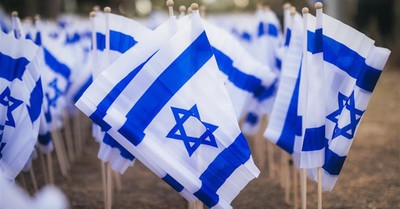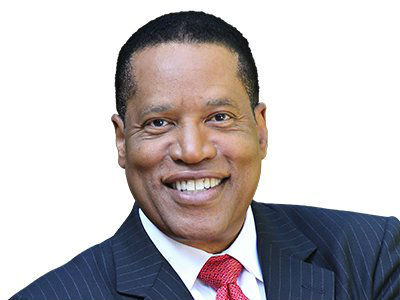Flags of Fellowship—God’s Banner Over Israel
Sponsored Content


Audio By Carbonatix
By International Fellowship of Christians and Jews, Crosswalk.com
Flags are more than just fabric. They embody identity. And they embody hope. A flag tells a story—it unites people under shared values, history, and purpose. When raised, a flag signals presence and perseverance. Even as many have turned their backs on Israel, people of faith—Christians and Jews together—still hold high the flag of Israel as a symbol of support, solidarity, and spiritual hope. But flying Flags of Fellowship is more than just ceremony. It ties each of us today to biblical tradition and to the miraculous story of God’s faithfulness to His Chosen People. The Bible itself tells of flags and banners, and Israel’s modern flag finds its roots in both Scripture and history. Raising Flags of Fellowship today is to take part in God’s ongoing promises to Israel—and to all who bless her.
Flags in the Wilderness
When The Chosen People encamped in the wilderness, God commanded:
“The Israelites are to camp around the tent of meeting some distance from it, each of them under their standard and holding the banners of their family.” (Numbers 2:2)
Each tribe had its own flag, bearing symbols drawn from Jacob’s ancient blessings to his sons. Judah’s displayed a lion, Levi’s the priestly breastplate, Benjamin’s a wolf, and so forth. These banners did more than mark territory. They declared each tribe’s identity, contribution, and calling within the larger people of Israel. But where did this idea of flags originate? The Jewish sages connect it to the giving of the Torah at Mount Sinai. At that moment, tradition says, 22,000 ministering angels surrounded the mountain—and each angel bore a flag. Just as no angel can fulfill more than one mission, each flag signified a specific purpose in God’s divine order.
The Israelites saw this heavenly vision and desired the same for themselves: a banner that would clarify their unique role and mission under God. And so, each tribe received a flag, not for self-glory, but to proclaim how their God-given strengths could serve the nation as a whole. This was unity without uniformity. The tribes were not absorbed into a single, faceless mass; rather, their differences were affirmed and ordered around the Tabernacle, the dwelling place of God. The message is timeless: individuality, when surrendered to God’s purposes, strengthens the whole. For us as people of faith today, the angels’ flags at Sinai and the tribes’ banners in the wilderness still carry the same lesson: clarity of mission brings power, and diversity under God’s authority brings unity. Just as Israel’s banners pointed toward the Tabernacle at the center, our lives and gifts should point toward God Himself, who alone brings His people together in purpose.
The Flag as Prophecy Fulfilled
Fast forward thousands of years. After exile, dispersion, and unimaginable suffering, the Jewish people longed for their homeland. The Zionist movement of the late 19th century gave visual form to this hope when the First Zionist Congress in 1897 designed a flag for the Jewish people. The design was simple yet profound: a white background symbolizing purity and rebirth; two blue stripes recalling the tallit, the prayer shawl, connecting heaven and tradition; and at the center, the Star of David, recalling Israel’s shepherd king and eternal capital, Jerusalem.
On May 14, 1948, at 4 p.m., the British lowered their flag over the land, ending nearly two millennia of foreign control. Immediately, Israel raised her flag. The nation’s first Prime Minister, David Ben-Gurion, declared the new state of Israel’s independence, and the new flag waved as the anthem Hatikvah—“The Hope”—rang out.
In the Bible, the prophet Isaiah wrote: “Who has ever heard of such things? Who has ever seen things like this? Can a country be born in a day or a nation be brought forth in a moment?” (66:8).
On that historic day, prophecy was fulfilled before the world’s eyes. A nation was reborn in a single day. The flag of Israel, fluttering against the sky, testified to God’s covenant faithfulness and His Word coming alive.
An Anthem of Hope
If the flag was the visual symbol of rebirth, Hatikvah was its soundtrack.
“Our hope is not yet lost,
The hope of two thousand years,
To be a free people in our land,
The land of Zion and Jerusalem.”
Hope had carried the Jewish people through exile, persecution, and even the Holocaust. As Holocaust survivor, author, and advocate Elie Wiesel wrote, “Just as a man cannot live without dreams, he cannot live without hope.” This hope was not vague optimism, but rooted in God’s promises through the prophets. As the prophet Jeremiah said in Lamentations:
“Yet this I call to mind and therefore I have hope:
Because of the Lord’s great love we are not consumed,
for his compassions never fail.” (3:21–22)
Every time the anthem is sung and the flag is raised, Israel remembers: hope was never lost. It was hope in God’s faithfulness that sustained generations and that continues to sustain His people today.
Flags as Answered Prayers
Abraham’s first prayer in the Bible is found in Genesis 18:23. And it was not for himself, but for others. Abraham, the father of our faith, prayed, “Will you sweep away the righteous with the wicked?” Though it seemed unanswered, Jewish tradition teaches that his prayer was fulfilled centuries later when God delivered Israel from Egypt. What looked delayed was, in fact, answered at just the right time. And so it was—and is—with the rebirth of Israel. Generations prayed for return and sovereignty, yet centuries passed. Holocaust survivors might have felt abandoned, but then came 1948—a flag raised, a nation reborn, a prayer answered. When Israel’s flag waves today, it reminds the world that no prayer is wasted. God hears, God remembers, and God answers—in His timing and for His glory.
Many Flags, One Purpose
The tribal flags of Numbers, the angels’ banners at Sinai, and Israel’s national flag today all share a theme: distinct identities united under God. For Christians and Jews standing together in today, raising the flag of Israel is not only solidarity, it’s an act of faith. It acknowledges God’s covenant with His people, honors His creation, and unites us all under His divine plan. Just as the tribes surrounded the Tabernacle, so too Israel’s friends surround her today—to support her, to honor her role in God’s story, and to join her in raising a banner of faith and hope. The flag of Israel, then, becomes a Flag of Fellowship. It is a signal to the world: God’s people are not alone, His promises are not forgotten, and His hope endures.
Flying Flags of Fellowship Together
As we fly Flags of Fellowship this year, each flag remembers a life lost on October 7, 2023. But each flag we fly also testifies to biblical prophecy fulfilled, to the endurance of hope, and to the faithfulness of our God who always keeps His promises. For the Jewish people, the flag has always meant homecoming, survival, and destiny. For Christians, it is the living proof that the God of Israel is true to His Word. And for all of us, as people of faith, it is a call to lift high our banner of faith, declaring to the world that hope is alive and God is at work.
As we read in the 20th Psalm: “May we shout for joy over your victory and lift up our banners in the name of our God” (v. 5).
Today, as Flags of Fellowship are flown, we echo King David’s declaration, in this movement of churches, synagogues, colleges, and faith leaders united in support for Israel, and praying and acting for God’s Chosen People.
To learn more about Flags of Fellowship visit ifcj.org/FOF.
Photo credit: ©International Fellowship of Christians and Jews
The International Fellowship of Christians and Jews is the leading non-profit building bridges between Christians and Jews, blessing Israel and the Jewish people around the world with humanitarian care and lifesaving aid.

























